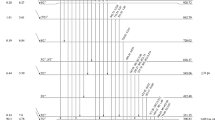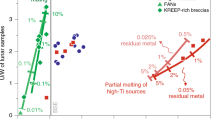Abstract
WE have succeeded in finding evidence of several isotopes of uranium which emit alpha-rays. In the expectation that the proportion of actino-uranium would be larger the younger the mineral, uranium from Colorado carnotite was used, the age of which has been variously estimated at from 170,000 to 7,000,000 years. The half-periods estimated by Wilkins1 and by Rutherford2 for actino-uranium, from quite different methods of reasoning, were 2.5 and 4.2 × 108 years respectively. The corresponding alpha-ray range would be about 3.2 cm.
This is a preview of subscription content, access via your institution
Access options
Subscribe to this journal
Receive 51 print issues and online access
$199.00 per year
only $3.90 per issue
Buy this article
- Purchase on Springer Link
- Instant access to full article PDF
Prices may be subject to local taxes which are calculated during checkout
Similar content being viewed by others
References
NATURE, 117, 719; 1926.
NATURE, 128, 313; 1929.
Author information
Authors and Affiliations
Rights and permissions
About this article
Cite this article
WILKINS, T., RAYTON, W. Isotopes of Uranium. Nature 130, 475–476 (1932). https://doi.org/10.1038/130475b0
Issue Date:
DOI: https://doi.org/10.1038/130475b0
This article is cited by
-
Nachweis von zwei neuen ?-Strahlern und einer neuen definierten Strahlung unbekannter Herkunft
Die Naturwissenschaften (1933)
Comments
By submitting a comment you agree to abide by our Terms and Community Guidelines. If you find something abusive or that does not comply with our terms or guidelines please flag it as inappropriate.



